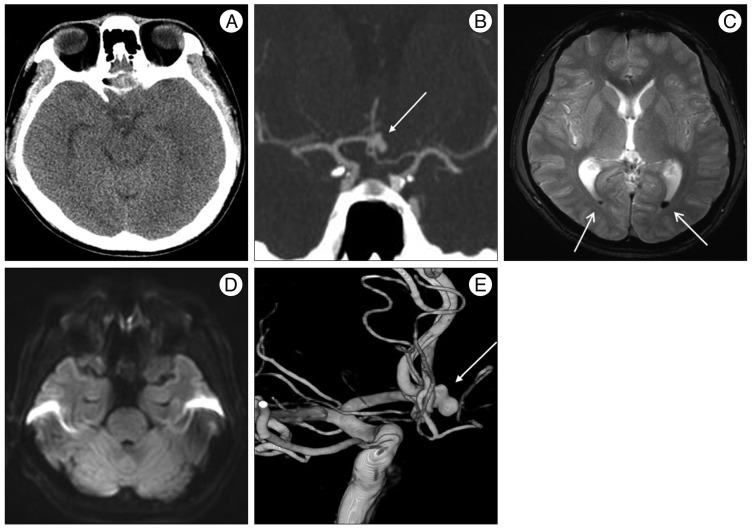J Korean Neurosurg Soc.
2013 Feb;53(2):112-114. 10.3340/jkns.2013.53.2.112.
Slowly Recovering Isolated Bilateral Abducens Nerve Palsy after Embolization of Ruptured Anterior Communicating Artery Aneurysm
- Affiliations
-
- 1Department of Neurosurgery, Seoul National University Hospital, Seoul, Korea.
- 2Department of Neurosurgery, SMG-Seoul National University Boramae Medical Center, Seoul, Korea. nslee@snu.ac.kr
- 3Department of Neurosurgery, Seoul National University College of Medicine, Seoul, Korea.
- KMID: 2190688
- DOI: http://doi.org/10.3340/jkns.2013.53.2.112
Abstract
- Bilateral abducens nerve palsy related to ruptured aneurysm of the anterior communicating artery (ACoA) has only been reported in four patients. Three cases were treated by surgical clipping. No report has described the clinical course of the isolated bilateral abducens nerve palsy following ruptured ACoA aneurysm obliterated with coil. A 32-year-old man was transferred to our institution after three days of diplopia, dizziness and headache after the onset of a 5-minute generalized tonic-clonic seizure. Computed tomographic angiography revealed an aneurysm of the ACoA. Magnetic resonance imaging showed focal intraventricular hemorrhage without brain stem abnormalities including infarction or space-occupying lesion. Endovascular coil embolization was conducted to obliterate an aneurysmal sac followed by lumbar cerebrospinal fluid (CSF) drainage. Bilateral paresis of abducens nerve completely recovered 9 weeks after ictus. In conclusion, isolated bilateral abducens nerve palsy associated with ruptured ACoA aneurysm may be resolved successfully by coil embolization and lumbar CSF drainage without directly relieving cerebrospinal fluid pressure by opening Lillequist's membrane and prepontine cistern.
MeSH Terms
Figure
Reference
-
1. Brazis PW. Isolated palsies of cranial nerves III, IV, and VI. Semin Neurol. 2009; 29:14–28. PMID: 19214929.
Article2. Göksu E, Akyüz M, Gürkanlar D, Tuncer R. Bilateral abducens nerve palsy following ruptured anterior communicating artery aneurysm : report of 2 cases. Neurocirugia (Astur). 2007; 18:420–422. PMID: 18008016.
Article3. Hashmi M, Siddiqi SA, Saleem F, Mustafa MS. Posterior reversible leukoencephalopathy. J Pak Med Assoc. 2007; 57:468–470. PMID: 18072644.4. Murad A, Ghostine S, Colohan AR. Role of controlled lumbar CSF drainage for ICP control in aneurysmal SAH. Acta Neurochir Suppl. 2011; 110(Pt 2):183–187. PMID: 21125469.
Article5. Nathal E, Yasui N, Suzuki A, Hadeishi H. Ruptured anterior communicating artery aneurysm causing bilateral abducens nerve paralyses--case report. Neurol Med Chir (Tokyo). 1992; 32:17–20. PMID: 1375980.
Article6. Patel SV, Mutyala S, Leske DA, Hodge DO, Holmes JM. Incidence, associations, and evaluation of sixth nerve palsy using a population-based method. Ophthalmology. 2004; 111:369–375. PMID: 15019392.
Article7. Rucker CW. The causes of paralysis of the third, fourth and sixth cranial nerves. Am J Ophthalmol. 1966; 61(5 Pt 2):1293–1298. PMID: 5938012.
Article8. Rush JA, Younge BR. Paralysis of cranial nerves III, IV, and VI. Cause and prognosis in 1,000 cases. Arch Ophthalmol. 1981; 99:76–79. PMID: 7458744.
- Full Text Links
- Actions
-
Cited
- CITED
-
- Close
- Share
- Similar articles
-
- Unilateral Abducens Nerve Palsy Associated with Ruptured Anterior Communicating Artery Aneurysm
- Isolated Bilateral Abducens Nerve Palsy Caused by Basilar Artery Dissecting Aneurysm
- Ruptured Posterior Communicating Artery Aneurysm Causing Bilateral Abducens Nerve Paralyses: Case Report
- Ruptured Anterior Communicating Artery Aneurysm Causing Bilateral Oculomotor Nerve Palsy: A Case Report
- Isolated ipsilateral abducens nerve palsy and contralateral homonymous hemianopsia associated with unruptured posterior cerebral artery aneurysm: A rare neurological finding



